Lyrids Lights, Galaxies Glow Brighter as the Bright Moon Exits Evening, Mercury Moves Up, Pre-dawn Planets on Parade!
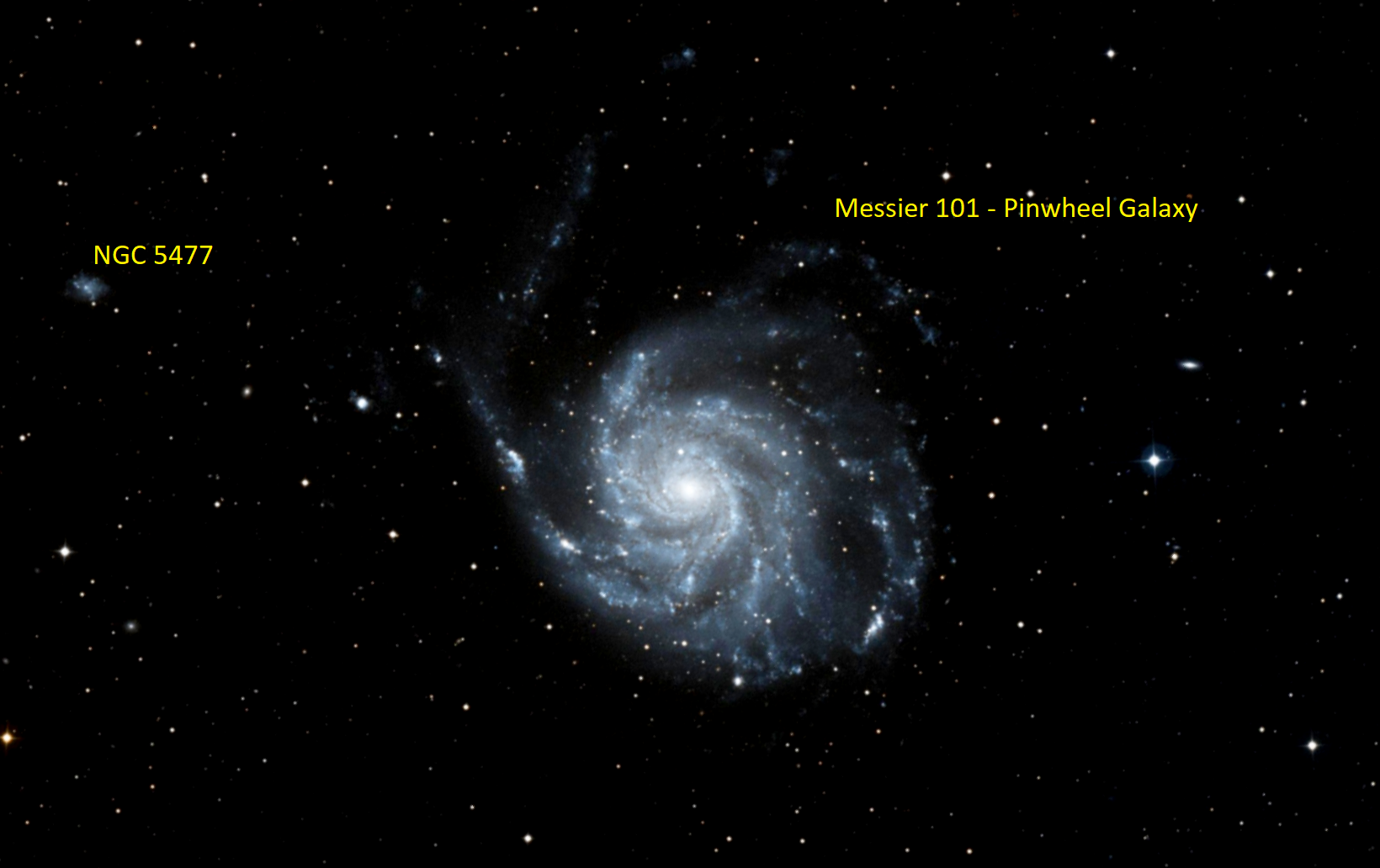
The glorious face-on spiral galaxy Messier 101, also known as the Pinwheel Galaxy, is located near the bright star Alkaid, at the tip of the Big Dipper’s handle. Visible even in binoculars, it is nearly overhead on April evenings. (Deep Sky Survey image from Stellarium)
Hello, mid-April Stargazers!
Here are your Astronomy Skylights for the week of April 17th, 2022 by Chris Vaughan. Feel free to pass this along to your friends and send me your comments, questions, and suggested topics. You can also follow me on Twitter as @astrogeoguy! Unless otherwise noted, all times are expressed in Eastern Time. To subscribe to these emails please click this MailChimp link.
If you’d like me to bring my Digital Starlab portable inflatable planetarium to your school or other daytime or evening event, or deliver a session online, contact me through AstroGeo.ca, and we’ll tour the Universe, or the Earth’s interior, together! My terrific new book with John A. Read entitled 110 Things to See With a Telescope is a guide to viewing the deep sky objects in the Messier List – for both beginners and seasoned astronomers. DM me to order a signed copy!
Saturday’s bright Paschal full moon will wane and transition to the midnight-to-dawn period this week. Meanwhile, Mercury will ascend the western sky after sunset, four bright planets will form a line before sunrise, and the Lyrids shower will peak on Thursday night. Once the moon exits the evening sky at week’s end, skies worldwide will darken enough to see galaxies. Read on for your Skylights!
The Moon
Greetings to those who observe Easter and Passover! The moveable feast of Easter is always observed on the Sunday that follows the first full moon after the March equinox, making yesterday the Paschal Full Moon for 2022 and Holy Saturday; and today is Holy or Easter Sunday. The name “paschal” is derived from “Pascha”, a transliteration of the Aramaic word meaning Passover. The Paschal moon controls when both Easter and Passover are observed, but in different ways. Passover or Pesach is celebrated from the 15th through the 22nd of the Hebrew month of Nissan in the Jewish lunar calendar. Nissan began on April 2, when the new moon could first be spotted in Israel, so Passover began at sundown on Friday, April 15 and will end at nightfall on Saturday, April 23. Easter and Passover are arriving rather late this year because March’s full moon occurred only 2.5 days before the equinox.
This is the week of the lunar month when our natural night light will rise during the middle hours of the night as it wanes towards third quarter. Those late rising times will allow the moon to linger into the morning daylight hours. Tonight (Sunday) the 97%-illuminated moon will shine like a beacon once it clears the treetops at about 10 pm local time. It’ll reach its highest point, due south, around 2:30 am. If you’re prowling the house around that time, you’ll have plenty of moonlight to guide your way. With only two months until the June Solstice’s highest noonday sun for the year, the moon is already being held low in the night sky – allowing its light to reach interior rooms!
Sunday night’s moon will hide the modest stars of Libra (the Scales) that surround it. When the waning gibbous moon rises in late evening on Monday, it will be approaching from the right (or celestial west) the row of white, medium-bright stars that form the claws of Scorpius (the Scorpion). From top to bottom (celestial north to south) the brightest claw stars are: Graffias (Beta Scorpii), Dschubba (Delta Scorpii), Nur (Pi Scorpii), and Rho Scorpii. Graffias and Dschubba are double stars. The very bright, reddish star Antares will shine to the lower left (celestial east) of them all. During the night, the moon’s eastward orbital motion will cause it to pass in front of (or occult) Dschubba. In the Greater Toronto Area, Dschubba will be covered by the bottom (southern) limb of the moon between 2:13 and 2:50 am EDT (or 06:13 to 06:50 Greenwich Mean Time). Use a backyard telescope to watch each of Dschubba’s close-together stars to vanish, and later re-appear, in rapid succession. Observers in some locations will only see the moon passing close to that star. Early risers on Tuesday morning can see the moon in Scorpius in the southwestern sky before dawn.
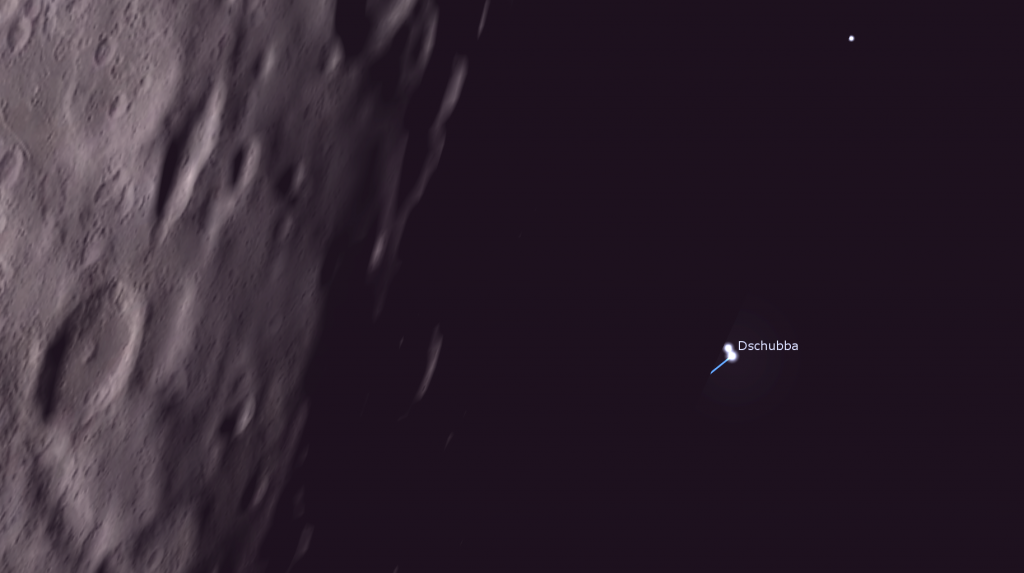
After a quick hop past the feet of Ophiuchus (the Serpent-Bearer) on Wednesday, the moon will spend Thursday and Friday crossing the Teapot-shaped stars of Sagittarius (the Archer). The moon will officially reach its third quarter phase at 7:56 am EDT or 11:56 GMT on Saturday morning. At third (or last) quarter the moon is half-illuminated, on its western, sunward side. It will rise around 3:30 am local time, and then remain visible until it sets in the western daytime sky in late morning. Its waning crescent will be travelling the stars of Capricornus (the Sea-Goat) all weekend.
On Sunday, the moon will shine a fist’s diameter to the lower right (or 9 degrees to the celestial southwest) of Saturn’s yellowish dot. Mars and the much brighter planets Venus and Jupiter will be arrayed off to the left (or celestial east), making a terrific photo opportunity when composed with some interesting scenery. The week of dark, moonless evening skies beyond next weekend will be the best ones for observing deep sky targets.
It’s Spring Galaxy Time!
Every spring in the Northern Hemisphere, the obscuring stars, gas and dust of our own Milky Way galaxy vacate the night sky overhead, leaving a literal window of opportunity for observers to see distant galaxies. The moonless evenings that commence around Thursday will provide us with the dark skies we need for seeing these faint, but majestic objects. The darkness will last through the first few days of May. If you don’t have clear skies, the next viewing opportunity will return in late-May.
On a clear, moonless evening, find a spot away from city lights and look east. About halfway up the sky, to the upper right of the bright star Arcturus, you’ll find the modest stars of the constellation of Coma Berenices, or “Bernice’s Hair.” Its patch of sky contains the north galactic pole and therefore far fewer stars than the rest of the sky. Coma, for short, moves to more or less overhead during late evening during April (and mid-evening during May) – perfect for viewing distant galaxies through the least amount of Earth’s distorting atmosphere. Coma Berenices and the constellations around it — Virgo (the Maiden), Leo (the Lion), Ursa Major (The Big Bear, and the Big Dipper’s home) and Canes Venatici (the Hunting Dogs) – all host a great many galaxies.
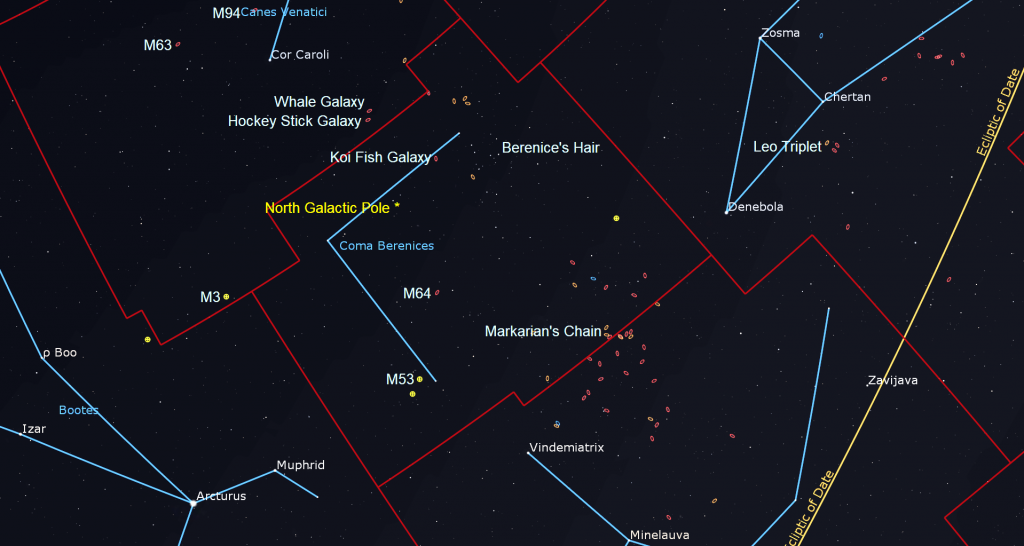
If you have a good-sized telescope (say a 4” or 102 mm aperture telescope, or larger) and a dark location that is free of light pollution, put your lowest power eyepiece (or lens) in it. That’s the one with the largest number printed on it. That long focal length eyepiece will show the largest possible patch of sky through a telescope – making finding galaxies easier. (You can also see many of the following targets in larger binoculars from dark sites.)
Now aim your telescope at the medium-bright star named Denebola, which marks the tail of Leo (the Lion), and focus it until Denebola is a pinpoint of light. Next, without changing the focus, aim at the spot exactly midway between Denebola and the medium-bright star Vindemiatrix in Virgo (the Maiden), which sits nearly two outstretched fist diameters to the lower left (or 17 degrees to the celestial east) of Denebola.
If your sky is dark and your eyes are dark-adapted, you should see a number of dim, fuzzy patches in the eyepiece. Those are members of the Virgo Cluster of Galaxies – some larger, some smaller. If you can’t be sure you’re seeing them, try lightly tapping telescope tube while you are looking. The smudges will jump around a little, allowing your brain’s wiring to see them better. Nudge the telescope around to see how many you can find. (There are dozens in that patch of sky). If you mess up the focus, or get lost, just start over.
The biggest and brightest galaxies in that neighbourhood are designated Messier 84 and Messier 86 (or M84 and M86). They are part of a curved line of galaxies known as Markarian’s Chain. In the early 1960’s, Armenian astrophysicist Benjamin E. Markarian discovered that those galaxies were travelling through the Universe as a gravitationally-bound group. Depending on your telescope type, their arc will curve down to the right or up to the right. Another prominent galaxy called M87 is located a short hop from the bend in the chain. If you recall the pictures in the news (three years ago this month) of an orange ring surrounding a Black Hole, M87 is the galaxy where it is located, some 60 million light-years away from us. Here’s the press release.
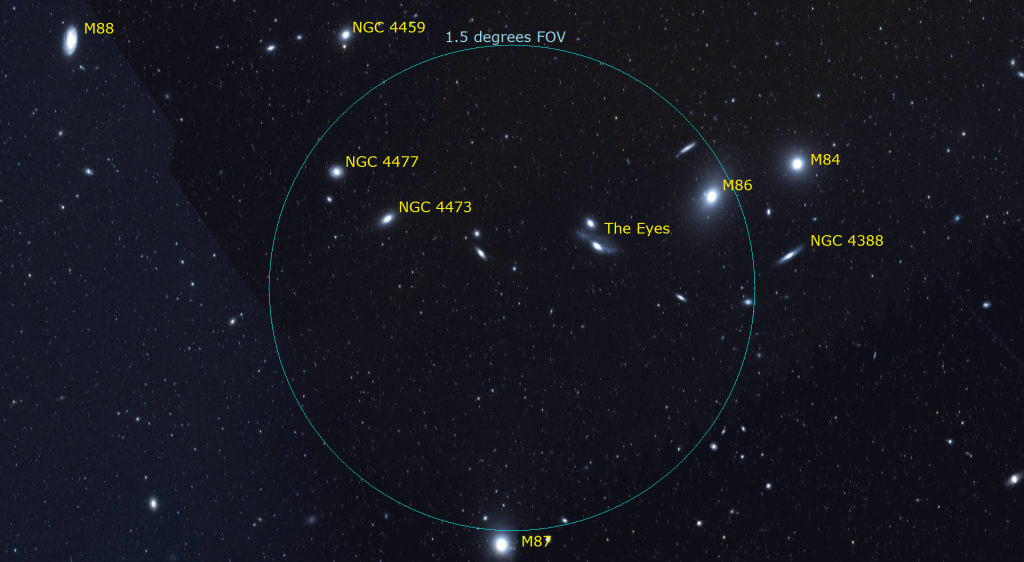
Galaxies that are oriented edge-on towards Earth appear in telescopes as short, indistinct, streaks of dim light. That’s because we’re seeing the collective light from all of that galaxy’s stars squeezed into a much smaller area of sky. Try to find the star named Gamma Comae Berenices (or γ Com or Al Dafirah). It’s close to the limit of visibility in light polluted skies, but easier to see in rural locations. That star is the uppermost of Coma Berenices’ three main stars. A collection of slightly dimmer stars gathered just to the right of Al Difirah represents the hair of Berenice. Those are easy to see using binoculars. Other names for the cluster include Ariadne’s Hair, Thisbe’s Veil, the Cobweb Cluster, the Flying Witch, Black Bart’s Hair, and Melotte 111.
From Al Dafirah, aim your telescope a slim palm’s width to the left (or 5.5 degrees to the celestial northeast). There you might glimpse the Whale Galaxy (or NGC 4631). It’s called that because, when combined with a second, smaller galaxy sitting just beside it, it resembles a whale blowing water from its spout. Another prominent galaxy called the Crowbar Galaxy, or Hockey Stick Galaxy (or NGC 4656) is positioned close enough to the whale to show up in the same field of view of your telescope. It, too, appears as a slim, fuzzy slash of light. Those two major galaxies are about 25 and 30 million light years away from us, respectively.

Returning to Al Dafirah, scan your telescope two finger widths to the lower left (or 2 degrees to the celestial east) of that star – in the direction of Coma’s brightest star Beta Com – and look for the Koi Fish Galaxy (or NGC 4559). Finally, point your telescope a few fingers widths below (or 3 degrees to the celestial southeast of) Al Dafirah. There you can look for the Needle Galaxy (or NGC 4565). This galaxy is dimmer than the other two, but it sits exactly edge-on to us – making it easier to see. It is located about 57 million light-years away from our solar system!
The Big Dipper asterism and its home constellation of Ursa Major (the Big Bear) are very high in the northern sky in late evening during early April – ideal for observing the spectacular galaxies they host in strong binoculars or backyard telescopes on moonless nights this week. Double the line connecting the dipper stars Phecda to Dubhe to arrive at the galaxy named Bode’s Nebula, otherwise known as Messier 81. It’s a magnitude 6.9 spiral galaxy oriented not quite face-on to Earth, making it appear relatively large and bright. A smaller, magnitude 8.4 galaxy named the Cigar Galaxy or Messier 82 is located half a degree to the north. That allows both galaxies to be viewed together in the eyepiece of a telescope at low magnification. Several other fainter galaxies can be found within a few degrees of Bode’s Nebula – so scan around.
Under dark sky conditions, two impressive galaxies can be seen in binoculars and backyard telescopes by using Alkaid, the bright star that marks the tip of the Big Dipper’s handle. The Pinwheel Galaxy, or Messier 101, is a spectacular and large, face-on spiral galaxy positioned a palm’s width to the left (if facing east) or 5.5 degrees to celestial north of Alkaid, forming an equilateral triangle with Mizar, the double star at the bend of the handle. This relatively close galaxy, only 21 million light-years away, is nearly as large as the full moon in the sky. Since the galaxy’s light is spread over such a large area, its overall brightness is low, however.

Aim your binoculars or telescope several finger widths to the upper right of Alkaid to discover the iconic Whirlpool Galaxy, aka Messier 51. This spiral galaxy’s angular size is smaller, but it will look somewhat brighter in your binoculars and telescope. A secondary galaxy core designated NGC 5195 sitting alongside M51 is linked to the main spiral by a bridge of material (stars and dust).
Let me know how you make out with your galaxy search!
The Planets
For observers located along mid-Northern latitudes, this week will offer the best opportunity to see the elusive planet Mercury in 2022. It will also be the worst appearance of Mercury for those in the Southern Hemisphere. Starting tonight (Sunday), look for Mercury’s bright dot shining just above the west-northwestern horizon as the sky begins to darken. The planet will climb higher and brighten on each subsequent night. By mid-week, Mercury will sit a generous palm’s width above the horizon at its best viewing time of about 9 pm local time. In a telescope, Mercury will show a football-shaped, waning gibbous disk. Always ensure that the sun has completely set before aiming binoculars or a backyard telescope towards the western horizon. Hang around after Mercury sets and locate the bright Pleiades star cluster in Taurus (the Bull) above it. Mercury will buzz that cluster at month’s end.

Four bright planets will continue to be arrayed like beads on a string in the eastern pre-dawn sky this week! By about 6 am local time on Monday morning, Jupiter’s bright white dot will gleam above the eastern horizon. Much brighter Venus, then red Mars, and finally, yellowish Saturn will be spread out in a 31 degrees-long line stretching to Jupiter’s upper right (celestial west). Their placement is showing you the plane of our solar system.
Head outside by about 5:30 am local time if you want to see Venus, Mars, and Saturn shining in a dark sky, surrounded by the stars of Capricornus (the Sea-Goat) and Aquarius (the Water-Bearer). Once the sky brightens, the fainter planets Mars and Saturn will fade from sight first.
If you pay attention to the spacing of the four planets, you’ll see faster Venus shift farther from Mars and closer to Jupiter during this week. Over the same period, Mars will widen its spacing from Saturn. Like Mercury, Venus will exhibit a football-shaped, gibbous phase in a telescope – but waxing instead of waning because they are on opposite sides of the sun. Good binoculars can reveal Venus’ shape, too. Any size of telescope will show you Saturn’s full globe, its rings, and perhaps a few of its moons. Mars will exhibit a tiny, 90%-illuminated disk. Jupiter will also get a little higher and farther from the sun with each passing day, allowing you to enjoy its dark equatorial bands, Great Red Spot, and four Galilean moons.

Lyrids Meteor Shower
The annual Lyrids Meteor Shower will peak overnight on Thursday-Friday, April 21-22.
Meteor showers occur when the Earth passes through zones of debris shed by repeated passages of periodic comets with orbits that intersect Earth’s. (An analogy would be the material tossed out of a dump truck as it rattles along. The roadway gets pretty dirty if the truck drives the same route a number of times!) Over centuries and millennia, the dust-sized and sand-sized particles accumulate in a zone that surrounds the comet’s orbit, with their distributions denser near the orbit and tapering off around it.
While the Earth plows through one of those clouds of cometary debris, particles are pulled in by our gravity and zip through our atmosphere at speeds on the order of 200,000 km/hr. The grains moving that fast through the air generate intense heat that ionizes the air in a long, narrow tube surrounding the particle – producing the long, glowing trails we see.
The duration of a particular meteor shower depends on the width of the debris cloud and whether the Earth moves across it perpendicularly, or performs a longer, oblique crossing. The shower’s intensity depends on whether we pass through the densest region, or merely skirt its edges. Since the Earth passes through the same part of the solar system on the same date every year, meteor showers repeat annually. Fluctuations in the geometry of the encounter can cause showers to vary from their predicted behavior – and even produce unexpected outbursts in some years.
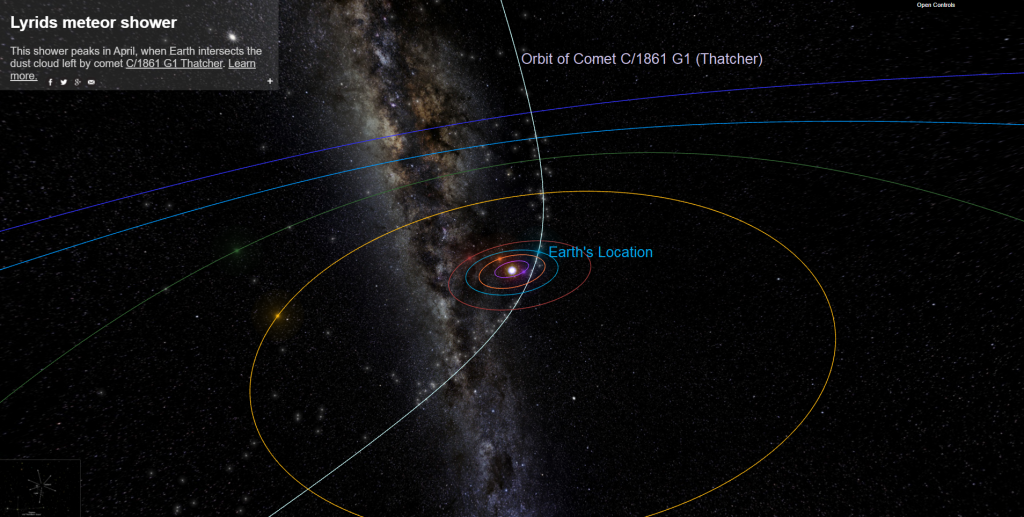
The source particles for the Lyrids shower is thought to be a comet named C/1861 G1 (Thatcher), after its discoverer A. E. Thatcher. It orbits the sun every 416 years, shuttling between the distant Kuiper Belt (110 times farther from the sun than we are) and just inside Earth’s orbit. It is expected to dive into the inner solar system next around the year 2283.
Meteor showers ramp up and then taper off during their active periods. For the Lyrids shower that’s April 16 through April 25. Expect up to 10-18 Lyrids meteors per hour at the peak – some manifesting as bright, sputtering fireballs! According to NASA, the Lyrids were documented by Chinese astronomers in 687 BCE – making this one of the oldest recorded meteor showers.
Usually, meteor showers are best observed in the dark skies before dawn, because that’s the time when the sky overhead is plowing directly into the oncoming debris field, like bugs splattering on a moving car’s windshield. The direction in the sky that is Earth is travelling towards (or the road ahead, to use my car analogy) is called the radiant. All the meteors from a particular shower’s source will seem to be travelling away from, or radiating, from that location. The constellation containing the radiant gives the shower its name. Long ago, the Lyrids radiant was located in the constellation of Lyra (the Harp), near the bright star Vega. Over time, the slow wobble of Earth’s axis has shifted the radiant into next-door Hercules.
The highest rates of Lyrids meteors this year are expected to occur from Thursday night into Friday morning April 21-22, when the Earth will be traversing the densest part of comet Thatcher’s debris field. If you begin to watch after dark on Wednesday evening, you might catch a few spectacular, very long meteors that are skimming the Earth’s upper atmosphere. As the night rolls on, the radiant will rise higher in the sky, revealing more meteors because they will no longer be hidden by the bulk of the Earth. Normally, the absolute best time to watch is when the radiant is almost overhead, between 4 and 5 am in your local time zone. But, for this year, a bright, 63%-illuminated moon will rise at 2:30 am local time – so focus on watching for Lyrids in late evening on Thursday and through the middle of the night.
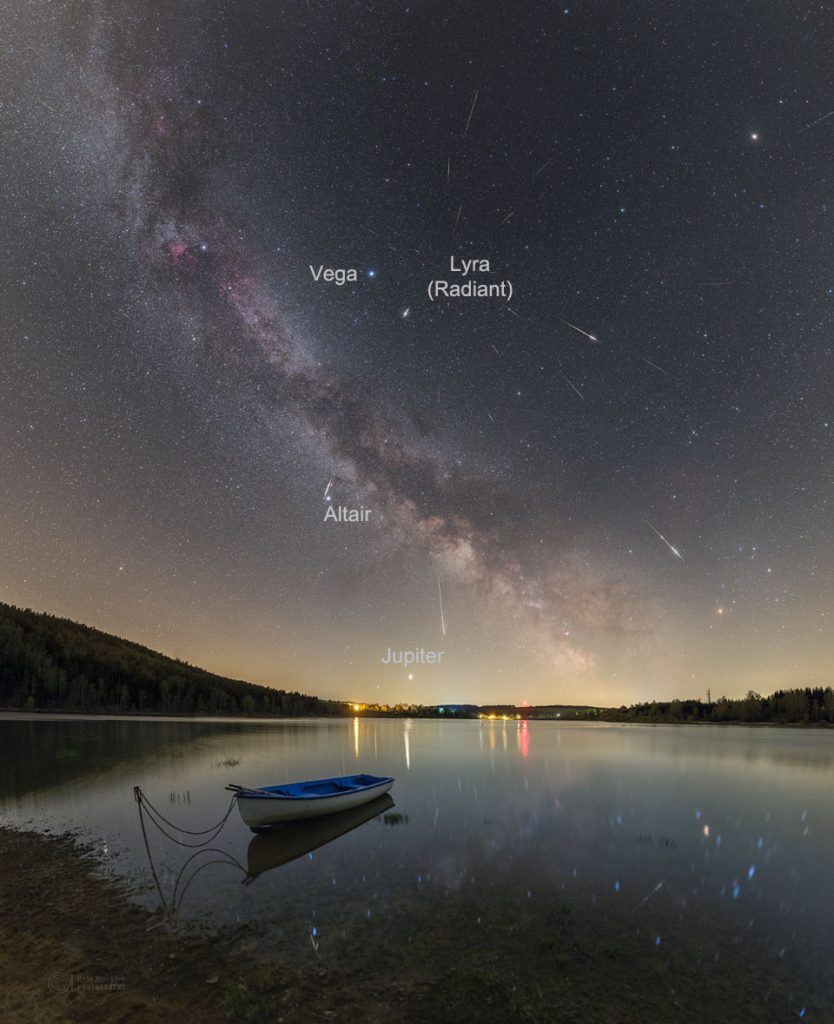
For best results, try to find a safe viewing location with as much open sky as possible. You can start watching as soon as it gets dark. Don’t bother watching the radiant. Meteors near there will be heading directly towards you and will have very short trails. But do try tracing the meteors backwards to their source.
Bring a blanket for warmth and a chaise to avoid neck strain, plus snacks and drinks. Try to continuously watch the sky, even when chatting with friends or family – they’ll understand. Call out when you see one; a bit of friendly competition is fun! You’ll also see plenty of satellites gliding silently and smoothly across the sky. (Airplanes have lights that flash while satellites emit a steady (or sometimes slowly pulsing) glint of reflected sunlight.)
Keep your phone or tablet tucked away – its bright screen will spoil your dark adaptation. If you can’t resist some screen time, minimize the brightness and/or cover the screen with red film. Disabling app notifications will reduce the chances of unexpected bright light, too. And remember that binoculars and telescopes will not help you see meteors because they have fields of view that are too narrow. Good luck!
By the way, the nickname for meteors is “shooting stars” or “falling stars”. But meteors bear no physical connection to the distant stars at all. All of your favourite constellations will look the same as ever at the end of the shower!
Public Astro-Themed Events
Every Monday evening, York University’s Allan I. Carswell Observatory runs an online star party – broadcasting views from four telescopes/cameras, answering viewer questions, and taking requests! Details are here. They host in-person viewing on the first clear Wednesday night each month. Other Wednesdays they stream views online via the observatory YouTube channel. Details are here.
On Wednesday evening, April 20 at 7:30 pm EDT, the RASC Toronto Centre will live stream their monthly Speakers Night meeting. This month will feature Dr. Carl E. Fields, RPF Distinguished Postdoctoral Fellow, Los Alamos National Laboratory. His talk is titled The Remarkable Death of a Massive Star, discussing the physics that leads to black holes, neutron stars, and nucleosynthesis. Everyone is invited to watch the presentation live on the RASC Toronto Centre YouTube channel. Details are here.
On Friday evening, April 22 at 7:30 pm EDT, the Speakers Night meeting of the RASC Mississauga Centre will feature Dr. Chris Impey, Steward Observatory, University of Arizona. His talk is titled Astrobiology – How strange life might be? It’s about the bizarre life forms that may populate our Universe. Everyone is invited to attend the presentation live on Zoom (link here). More details are here.
Public sessions at the David Dunlap Observatory may not be running at the moment, but RASC are pleased to offer some virtual experiences instead in partnership with Richmond Hill. The modest fee supports RASC’s education and public outreach efforts at DDO.
On Saturday night, April 23 from 8:30 to 10:00 pm EDT, tune in for DDO Up in the Sky. During the family-friendly session, RASC astronomers will live-stream views through their telescopes and the giant 74” telescope at DDO (pre-recorded views will be used if skies are cloudy). Only one registration per household is required. Deadline to register for this program is Wed., April 20, 2022 at 3 pm. Prior to the start of the program, registrants will be emailed the virtual program links. More information is here and the registration link is here.
On Sunday afternoon, April 24 from 12:30 to 1 pm EDT, tune in for DDO Sunday Sungazing. Safely observe the sun with RASC, from the comfort of your home! During these family-friendly sessions, a DDO Astronomer will answer your questions about our closest star: the sun! Learn how the sun works and how it affects our home planet. Live-streamed views of the sun through small telescopes will be included, weather permitting. Only one registration per household is required. Deadline to register for this program is Wed., April 20, 2022 at 3 pm. Prior to the start of the program, registrants will be emailed the virtual program links. More information is here and the registration link is here.
My free, family-friendly Insider’s Guide to the Galaxy webcasts with Samantha Jewett of RASC National returns on Tuesday, April 26 at 3:30 pm EDT, when we’ll uncover the mysteries of the constellation Leo, the Lion. Plus, we’ll continue with our Messier Objects observing certificate program and share some galaxy-viewing tips. You can find more details and the schedule of future sessions here.
Don’t forget to take advantage of the astronomy-themed YouTube videos posted by RASC Toronto Centre and RASC Canada.
Space Station Flyovers
The ISS (or International Space Station) will not be visible gliding silently over the GTA this week.
Keep looking up, and enjoy the sky when you do. I love questions and requests. Send me some!